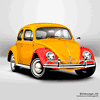
Published 06/23/22
With Germany in ruins, the general population and military occupying forces needed transportation. And Volkswagen had the perfect vehicle for that. Administered by the British at the time, the Volkswagen factory in Wolfsburg soon began churning out cars. However, the military management was not much worried about branding their product. Internally at VW, they just called their car the Typ 1 (Type 1). A short few years later production shifted toward the civilian market. And with VW established as a proper “commercial venture”, the name became important. So, with typical Teutonic efficiency, their only model was the Volkswagen Sedan (“VW Limousine”, in German). Notedly, in workshop manuals and factory documentation, it was described as Typ 1. Yet, because of its shape, people nicknamed it the Beetle (or Käfer, in German). As VW began exporting and later on building in other countries, the car received many different local nicknames.

Just to cite a few, you have Fusca (or also Fuque) in Brazil. It was Vocho or Vochito in Mexico and Peta (turtle) in Bolivia. In Iceland it was Bjalla (beetle) and Kodok (frog) in Malaysia. The Portuguese called it Carocha (beetle), however it was Garbus (hunchback) in Poland. And in Norway it was Boble (bubble). The list is absurdly HUGE. Almost every country that received the Beetle (imported or locally produced) had a local nickname for it. And since it reached all four corners of the world, no other vehicle received so many different names.

The same happened with VW’s second vehicle, the commercial Transporter or Bus. After the war, the Germans also needed a cheap and reliable transporter, for people and goods. Since the Käfer was the Typ I, logically the new transporter would be the Type II (Typ II, in German). With production starting in 1949, VW designated it Kombinationsfahrzeug or Kombinationskraftwagen (combination motor vehicle or combine-use vehicle). With that, people nicknamed the transporter, in all its forms, the Kombi. At the time, alternatively many also called it the “Bulli”. Bulli most likely was short for “Bus und Lieferwagen“ – bus and delivery van. In fact, some say that should have been the official name. However, due to trademark issues, VW couldn’t register it. Still, the name stuck, and the transporter became the Bulli or Kombi.

The Kombi followed the Käfer’s success, and just like the Bug, it was exported and produced everywhere. And of course, it received nicknames. In North America it was called Bus, Vee-dub or the Hippie-mobile, among others. For Mexico and most of Latin America it was the Combi (in Brazil it was Kombi). In Portugal it was the Pão-de-forma (bread loaf). For the Danes the Type 2 was the Rugbrød (rye bread), while Fins called it Kleinbus (mini-bus). A long list, however not as extensive as the one for the Beetle. Nonetheless, it also shows the importance of the Kombi in the automotive world. Nowadays the Kombi is classified as T1 through T6, according to year of production. Yet, VW created that classification in 1990, so it was not referred to as such before 1990.

At least until 1961, VW did not refer to the Volkswagen Limousine as Beetle, Käfer, Fusca, etc. The Type III, introduced in 1961, officially was the VW 1500 and the Type 1 the VW 1100, 1200 or 1300. By then, “the Beetle” was already a well-known name worldwide. While that was the case, VW only used the term extra-officially, and written in inverted commas. VW first used the name Beetle in 1967, in marketing materials for the US. However, in 1969, the name Beetle became the official generic term for all models. Consequently, gradually in other markets VW also adopted the local nickname. As expected, shortly after, the same happened with the Bus.

Interestingly, the rear window also is a way to name the Beetle. Nowadays, if someone says “split window Beetle”, they’re talking about models up to 1952. If they say “oval window Beetle”, they’re referring to models from 1953 to 1957. Since the split window looks like a pretzel, in Germany they call pre-1953 models Brezelkäfer (“pretzel Beetle”). For the Kombi, the front windshield created a nickname. From 1949 to 1967 the windshield was divided in the middle. Therefore, Transporters from those years are called “Splittys”.

At least until the New Beetle of 1997, the VW Käfer and Kombi had official different names in each country. No other car in automotive history had such a distinction. And with such a history, that’s why I have them in my collection. However, so many official names make things a bit confusing. Or at least I was confused, when I started research on them. To me, it was always “Fusca” and “Kombi”, since that was what VW Brazil called them since I was a kid (or Beetle and Bus, in the USA). Only after I got my Vocho Open Air did I learn the huge variation in nomenclature. To the best of my knowledge, no other car has such a diverse nomenclature. And that applies even to other so-called “world cars”, like the VW Golf or Ford Mondeo, produced in more than one country.


Another aspect that I find interesting is VW’s logos. With the years, they changed quite a lot, and all due to global politics. Since VW is a huge international manufacturer, the winds of world politics affect their image. Well, in fact, back in the 50s VW affected world politics… If you want to know more about each one, click here. On that link you will find an interesting analysis of how and why the logo changed.


